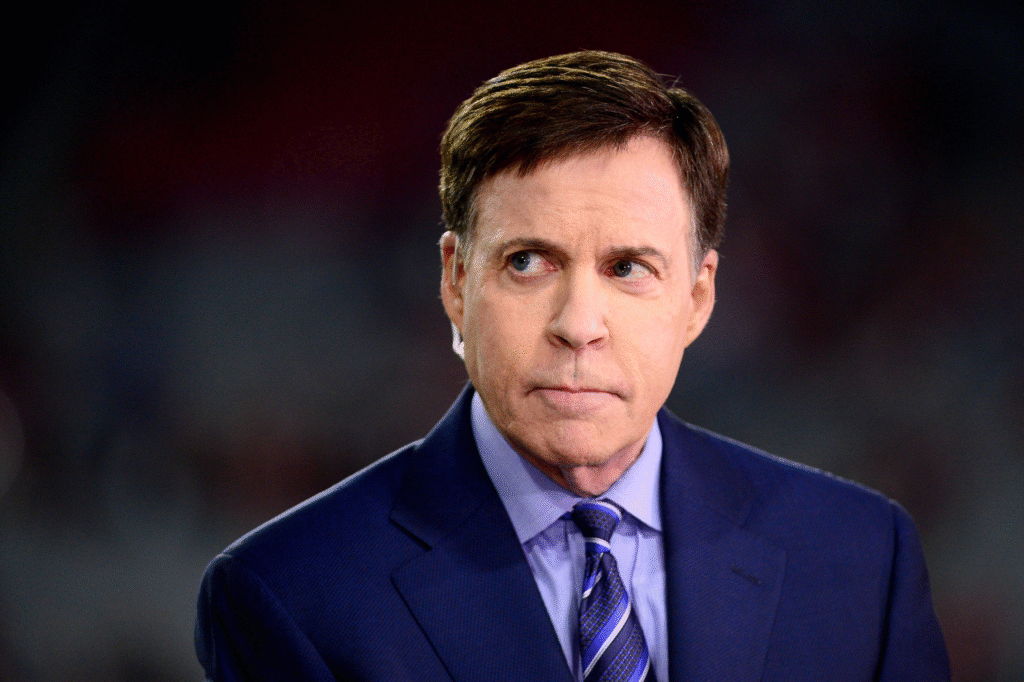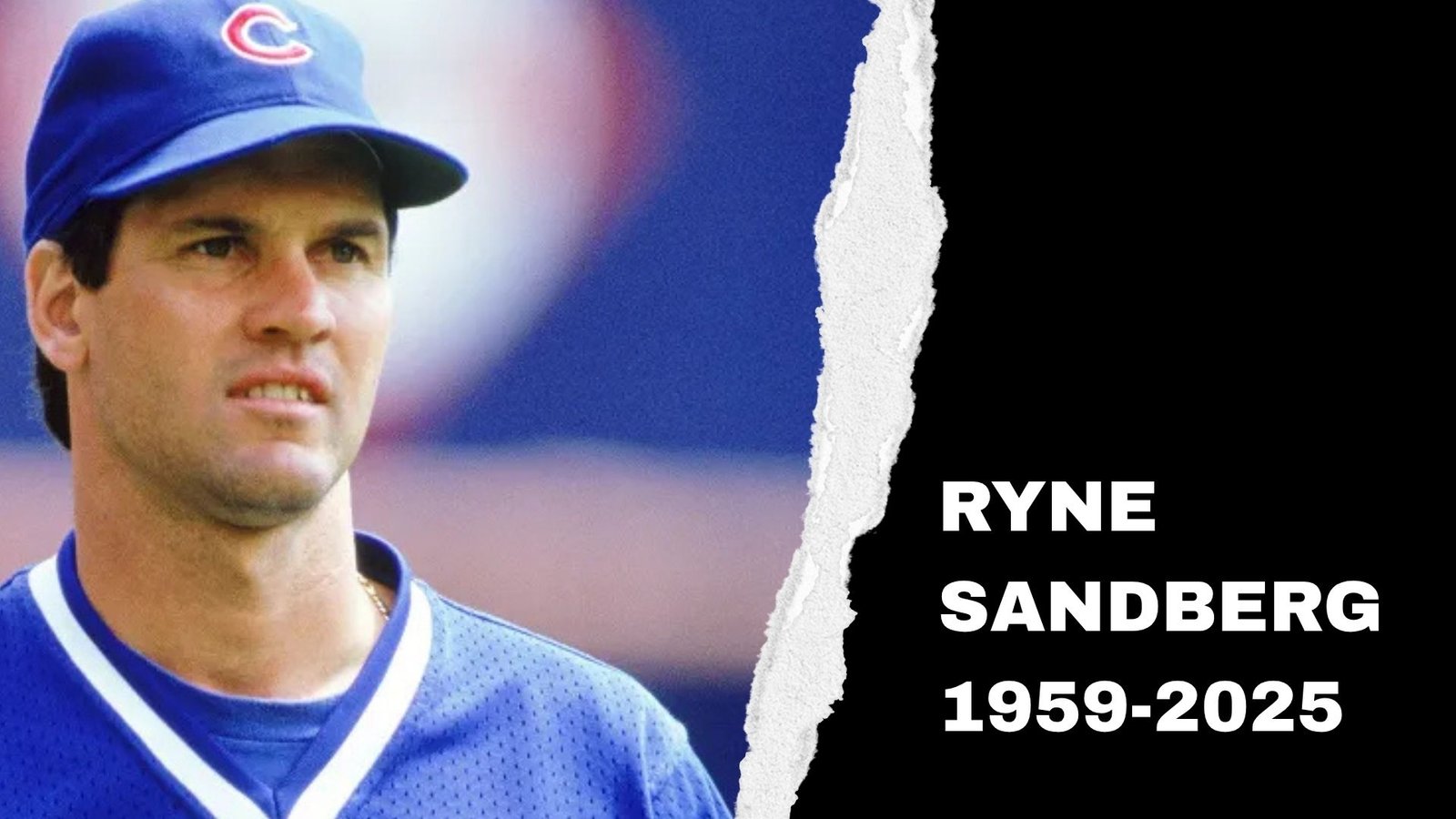The news arrived as a quiet, somber final out on a long summer day. Ryne Sandberg, the stoic Hall of Fame second baseman who for a generation embodied the heart and soul of the Chicago Cubs, died on Monday, July 28, 2025. He was 65. Surrounded by his family at his home in Lake Bluff, Illinois, the man affectionately known as “Ryno” concluded a courageous and public battle with cancer, leaving behind a city and a sport in mourning.
His final fight was one he chose to share with the fans who had adored him for decades. In January 2024, Sandberg announced he had been diagnosed with metastatic prostate cancer. He faced it with the same quiet determination that defined his career, undergoing chemotherapy and radiation treatments that led to a moment of hope in August 2024, when he declared he was cancer-free. But the disease was relentless. In a heartfelt Instagram post on December 10, he shared the devastating news that the cancer had returned and spread to other organs. Even then, his message was one of fortitude. “We will continue to be positive, strong, and fight to beat this,” he wrote, vowing to make the “most of every day with my loving family and friends”.
For a man known for his reserved nature and a preference for letting his play do the talking, this public vulnerability was a final act of leadership. He understood the weight his words carried and the hope he could offer. He appeared at Cubs spring training, a welcome and inspiring presence for a new generation of players, and threw out the ceremonial first pitch on opening day in April, a poignant moment at the ballpark he called home. He was fighting for his life, but he was still serving as an ambassador for the game he loved.
The outpouring of grief was immediate and profound. Cubs chairman Tom Ricketts called Sandberg “a hero to a generation of Chicago Cubs fans,” praising his “unrelenting integrity, grit, hustle, and competitive fire”. MLB Commissioner Rob Manfred eulogized him as a “beloved figure throughout Major League Baseball” and a “five-tool player who excelled in every facet of the game”. The tributes from those who shared the clubhouse with him painted a picture of a revered mentor and teammate. “Ryno was a great teammate and obviously a great player,” Hall of Fame pitcher Greg Maddux said in a text message to The Associated Press. “He led by example on the field and a mentor off. I was lucky to know him”. Cubs president of baseball operations Jed Hoyer placed him in the pantheon of Chicago sports gods, alongside Michael Jordan and Walter Payton, adding, “I can’t imagine a person handling their fame better, their responsibility for a city better than he did”.

The All-American Kid from Spokane: Forging a Foundation of Humility
Long before he was a Chicago icon, Ryne Dee Sandberg was a quiet kid from Spokane, Washington, born on September 18, 1959, to Derwent “Sandy” Sandberg, a mortician, and Elizabeth “Libby” Sandberg, a registered nurse. The ethos of his life can be traced back to the no-nonsense wisdom his father imparted: “Keep your mouth shut and eyes and ears open. Then you might learn something”. It was a code he would live by, a philosophy that shaped his entire public persona.
Baseball was woven into the family’s fabric. His parents, who met as pen pals during World War II, named their youngest son after New York Yankees relief pitcher Ryne Duren, a choice that seemed to chart his course from birth. His older brother, Del, was named for Philadelphia Phillies star Del Ennis, further steeping the household in the lore of the game.

At North Central High School, Sandberg was a prodigious athletic talent, but not just on the diamond. He was a three-sport star who excelled as a quarterback, earning Parade magazine All-America honors and setting a league passing record that would later be broken by future Super Bowl MVP Mark Rypien. He was also an all-league forward in basketball. Football powerhouses like Oklahoma and Nebraska recruited him, and he signed a letter of intent to play quarterback for Washington State University. Yet, in a quiet moment, he confided in his high school coach that his true passion was baseball.
This quiet conviction led him to a fateful decision. When the Philadelphia Phillies took a flyer on him in the 20th round of the 1978 amateur draft, selecting him 511th overall, he was seen as a longshot. He was an elite football prospect, but in baseball, he was an afterthought. This disparity likely instilled a deep-seated need to prove himself in his chosen sport. Phillies scout Bill Harper met with the family, who were understandably concerned about Ryne forgoing a college education. After a walk with his brother Del, the 18-year-old Sandberg accepted a modest $20,000 signing bonus and chose the uncertain path of professional baseball. It was a decision rooted in family and a quiet self-belief, setting the stage for a career built not on entitlement, but on relentless effort.
The Trade of the Century: A Phillie’s Loss, A Cub’s Birth
Sandberg’s career in Philadelphia was short and unremarkable. He made his major league debut on September 2, 1981, appearing in 13 games and managing just a single hit. In a poetic twist of fate, that lone single came at Wrigley Field, a harbinger of the greatness that would unfold on that very ground. The Phillies, a veteran team with stars like Mike Schmidt and Manny Trillo, saw Sandberg as a blocked prospect, a spare part in a championship machine.
His career, however, had a champion in Dallas Green. Green, who was the Phillies’ director of scouting when they drafted Sandberg, had always believed in the kid from Spokane. When Green left Philadelphia to become the general manager of the perennially struggling Chicago Cubs in 1981, he saw an opportunity. In negotiating a trade centered on veteran shortstop Larry Bowa for Iván DeJesús, Green insisted that the young Sandberg be included in the deal. The Phillies’ front office, guided by scouts who dismissed Sandberg’s potential as nothing more than a “utility infielder,” reluctantly agreed.
It was a franchise-altering mistake for the Phillies and a franchise-defining masterstroke for the Cubs. The trade, which would become known as one of the most lopsided in baseball history, demonstrated that raw talent often needs an advocate to flourish. Without Dallas Green’s belief and his insistence on acquiring the player he had championed as a scout, Ryne Sandberg’s Hall of Fame trajectory might never have begun. He was in the right place, at the right time, with the right person fighting in his corner.
“Ryno”: The Reign of a Five-Tool King
Upon arriving in Chicago, Sandberg’s journey to stardom began in earnest. He started his Cubs career at third base in 1982 but was shifted to second base the following year after the team acquired veteran Ron Cey. The move was seamless and historic. In 1983, he won the first of his nine consecutive Gold Glove Awards, becoming the first player in National League history to win the award in his first full season at a new position.
The year 1984 was his coronation. At the urging of manager Jim Frey, who encouraged him to be more aggressive and drive the ball for power, Sandberg transformed from a solid lineup piece into a bona fide superstar. He won the National League MVP Award, batting.314 and leading the league with 114 runs and 19 triples. His performance was the engine that drove the Cubs to their first postseason appearance since 1945, shattering decades of futility.
| Ryne Sandberg Career Accolades & Statistics | |
| Years Played | 1981-1994, 1996-1997 |
| Teams | Philadelphia Phillies, Chicago Cubs |
| Batting Average | .285 |
| Hits | 2,386 |
| Home Runs | 282 |
| Runs Batted In | 1,061 |
| Stolen Bases | 344 |
| Awards & Honors | National League MVP (1984) |
| 10x All-Star (1984–1993) | |
| 9x Gold Glove Award (1983–1991) | |
| 7x Silver Slugger Award (1984, 1985, 1988–1992) | |
| Home Run Derby winner (1990) | |
| Chicago Cubs No. 23 retired | |
| Baseball Hall of Fame (Inducted 2005) |
The Sandberg Game: A Legend is Born
The moment that catapulted him from a Chicago favorite to a national icon came on a sun-drenched Saturday afternoon at Wrigley Field. On June 23, 1984, in a nationally televised “Game of the Week” against the archrival St. Louis Cardinals, Ryne Sandberg authored a performance for the ages.
The Cubs, trying to shed their “lovable losers” reputation, trailed 9-8 in the bottom of the ninth inning against Hall of Fame closer Bruce Sutter, one of the most dominant relievers of his era. Sandberg, not yet known for his power, led off the inning and launched a game-tying home run into the left-field bleachers, sending the Wrigley faithful into a frenzy. The Cardinals, however, struck back, scoring two runs in the top of the tenth to take an 11-9 lead. The comeback seemed to have fallen short. But in the bottom of the tenth, with two outs, Sandberg came to the plate again, once more facing the formidable Sutter. He promptly hit another home run, a two-run shot to the same part of the ballpark, tying the game at 11.
The moment was immortalized by NBC broadcaster Bob Costas’s incredulous call: “Do you believe it?! It’s gone!”. The Cubs would go on to win 12-11 in the 11th inning, but the day belonged to Ryno. “The Sandberg Game” not only put him on the national map but also gave the team and its long-suffering fans the belief that 1984 was their year. Sandberg himself later reflected that the game “brought new standards for me each and every year”.

A Decade of Dominance
That game was the catalyst for a decade of unparalleled excellence. Sandberg became a 10-time All-Star and the gold standard for defensive second basemen, at one point playing 123 consecutive games without an error, a major league record. He possessed a rare combination of power and speed, stealing a career-high 54 bases in 1985 and leading the entire National League with 40 home runs in 1990—a feat almost unheard of for a second baseman. He is one of only a few players in MLB history to record both a 40-homer season and a 50-steal season. When he retired, his 277 home runs as a second baseman were the most in history. His quiet, consistent brilliance redefined what was possible at his position.
| Ryne Sandberg: Career Accolades & Milestones |
| Major Awards |
| National Baseball Hall of Fame |
| National League MVP |
| Gold Glove Awards (2B) |
| Silver Slugger Awards (2B) |
| All-Star Selections |
| Chicago Cubs Honors |
| Number 23 Retired |
| Chicago Cubs Hall of Fame |
| Wrigley Field Statue |
| Key Career Statistics (MLB) |
| Batting Average / Hits |
| Home Runs / RBIs |
| Runs Scored / Stolen Bases |
| Notable Achievements |
| NL Home Run Leader |
| NL Runs Scored Leader |
| MLB Record (at retirement) |
| MLB Record |
The Interruption: The Man Behind the Myth
On June 13, 1994, the seemingly unflappable foundation of the Chicago Cubs cracked. Ryne Sandberg, struggling with a career-low.238 batting average, abruptly retired from baseball. He walked away from the final years of a record-setting $28.4 million contract, an almost unthinkable act in professional sports. The public reason was a matter of principle, a reflection of the impossibly high standards he set for himself. “I am not the type of person who can be satisfied with anything less than my very best effort and my very top performance,” he stated.
But beneath the surface, the story was far more complex. His decision was fueled by a confluence of private pain and professional disillusionment. His 15-year marriage to his high school sweetheart, Cindy White, was ending in a difficult divorce, and he yearned to be a “full-time father” to his two children, Lindsay and Justin. Compounding his personal turmoil were persistent and sordid clubhouse rumors—never confirmed but widely circulated—that his wife had been unfaithful with a teammate, adding an unbearable layer of stress to his life.
Professionally, he had grown deeply frustrated with the direction of the team under General Manager Larry Himes, who he felt had “ripped (the Cubs) to shreds” by trading away dedicated players and creating a “rudderless ship”. This retirement was not an act of quitting; it was an act of radical integrity. He could have coasted, collecting his paycheck while his performance and passion waned. Instead, he chose to walk away from millions because he could not be a version of himself that he didn’t respect.
After sitting out for a season and a half, Sandberg announced his return for the 1996 season. He had remarried Margaret Facio, found a new sense of personal peace, and was motivated by a renewed love for the game and a desire for his children to see him play with joy. He played two more solid seasons before retiring for good after 1997, this time on his own terms. His departure and return revealed a man governed by an unwavering internal code, one that would define the rest of his life.
The Second Act: A Life Defined by Respect
After his playing days were over, Sandberg chose a path that reflected his deep-seated values. Instead of taking a high-profile broadcasting job, he embarked on a journey to become a manager, starting from the very bottom. In 2007, the Hall of Famer could be found in the dugout of the Class-A Peoria Chiefs, paying his dues and learning the craft of managing with the same diligence he applied to turning a double play. He methodically worked his way up the Cubs’ minor league system, earning Manager of the Year honors and widespread admiration for his humility and work ethic.
When the Cubs’ managerial job opened in 2010 and went to Mike Quade instead, Sandberg, in a move that spoke to his ambition, left the organization that had defined him. He joined the Phillies system, eventually earning the top job in Philadelphia, where he managed from 2013 to 2015. His tenure was a struggle. His quiet, “old school,” lead-by-example style did not always resonate in a modern clubhouse, and with a 119-159 record, he once again made a principled departure, resigning mid-season in 2015 when he felt the situation was untenable.
The ultimate expression of his life’s philosophy came on a summer day in Cooperstown in 2005. His Hall of Fame induction speech was a masterclass in humility and a sermon on the values he held sacred. The central theme was a single word: “Respect”. He spoke of playing the game the right way, of the importance of fundamentals over flash. “Hit a home run — put your head down, drop the bat, run around the bases,” he preached, “because the name on the front is a lot more important than the name on the back”. He thanked the fans of Chicago, who “took me into their homes and into their hearts and treated me like a member of their family”.
He returned to the Cubs organization in 2016 as a goodwill ambassador, a role that perfectly suited him. He became a beloved fixture at Wrigley Field, mentoring young players and connecting with generations of fans. Alongside his wife, Margaret, he founded Ryno Kid Care, a charity dedicated to helping children with serious medical conditions, extending his legacy of quiet service beyond the foul lines.
Conclusion: The Bronze on the Corner of Clark and Addison
For an entire generation of baseball fans, particularly those across the Midwest who grew up with the WGN signal bringing Cubs games into their homes every afternoon, Ryne Sandberg was more than a player. He was their player. He was the face of the franchise, the quiet hero in pinstripes. He was Chicago’s No. 23 before Michael Jordan made it globally famous. Every kid who played second base in a dusty park tried to emulate his smooth fielding and his slightly hunched stance at the plate.
It was fitting, then, that his final public honor came on June 23, 2024—the 40th anniversary of “The Sandberg Game”. On that day, the Cubs unveiled a bronze statue of him outside Wrigley Field. The ceremony, coming in the midst of his cancer battle, was imbued with a profound and poignant weight. His words that day revealed a man who, facing his own mortality, had gained a new perspective.
“My thoughts today are instead about love, life, family and friends,” Sandberg told the adoring crowd. “I feel that love now. It was always there. But I was too busy grinding out an extra 60 ground balls every morning to know that it was happening. We are who we are and that was me. I love you guys”.
It was a beautiful, heartbreaking admission from a man who had spent a lifetime focused on the work, finally allowing himself to feel the warmth of the sun. The statue, once a monument to a living legend’s career, now stands as a permanent, somber memorial. It immortalizes not just the MVP, the Gold Glover, and the Hall of Famer, but Ryno—the quiet, dignified, and respected man from Spokane who fought his final battle with the same integrity that defined his life. He remains, in bronze and in memory, a North Side sun that will never truly set.







